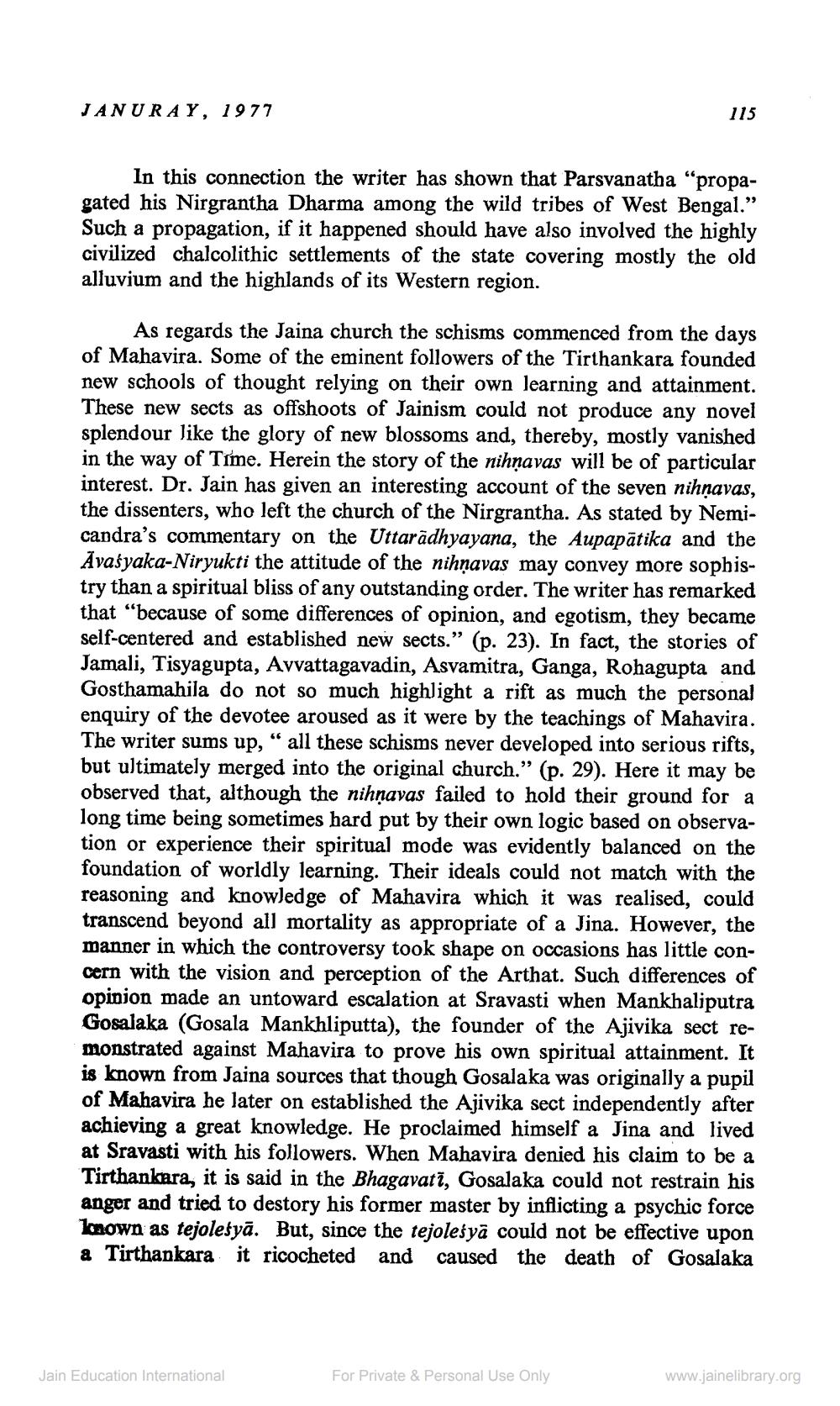Book Title: Jain Journal 1977 01 Author(s): Jain Bhawan Publication Publisher: Jain Bhawan Publication View full book textPage 4
________________ JANURAY, 1977 115 In this connection the writer has shown that Parsvanatha "propagated his Nirgrantha Dharma among the wild tribes of West Bengal." Such a propagation, if it happened should have also involved the highly civilized chalcolithic settlements of the state covering mostly the old alluvium and the highlands of its Western region. As regards the Jaina church the schisms commenced from the days of Mahavira. Some of the eminent followers of the Tirthankara founded new schools of thought relying on their own learning and attainment. These new sects as offshoots of Jainism could not produce any novel splendour like the glory of new blossoms and, thereby, mostly vanished in the way of Time. Herein the story of the nihnavas will be of particular interest. Dr. Jain has given an interesting account of the seven nihnavas, the dissenters, who left the church of the Nirgrantha. As stated by Nemicandra's commentary on the Uttaradhyayana, the Aupapātika and the Āvaśyaka-Niryukti the attitude of the nihṇavas may convey more sophistry than a spiritual bliss of any outstanding order. The writer has remarked that "because of some differences of opinion, and egotism, they became self-centered and established new sects.” (p. 23). In fact, the stories of Jamali, Tisyagupta, Avvattagavadin, Asvamitra, Ganga, Rohagupta and Gosthamahila do not so much highlight a rift as much the personal enquiry of the devotee aroused as it were by the teachings of Mahavira The writer sums up," all these schisms never developed into serious rifts, but ultimately merged into the original church.” (p. 29). Here it may be observed that, although the nihộavas failed to hold their ground for a long time being sometimes hard put by their own logic based on observation or experience their spiritual mode was evidently balanced on the foundation of worldly learning. Their ideals could not match with the reasoning and knowledge of Mahavira which it was realised, could transcend beyond all mortality as appropriate of a Jina. However, the manner in which the controversy took shape on occasions has little concern with the vision and perception of the Arthat. Such differences of opinion made an untoward escalation at Sravasti when Mankhaliputra Gosalaka (Gosala Mankhliputta), the founder of the Ajivika sect remonstrated against Mahavira to prove his own spiritual attainment. It is known from Jaina sources that though Gosalaka was originally a pupil of Mahavira he later on established the Ajivika sect independently after achieving a great knowledge. He proclaimed himself a Jina and lived at Sravasti with his followers. When Mahavira denied his claim to be a Tirthankara, it is said in the Bhagavatī, Gosalaka could not restrain his anger and tried to destory his former master by inflicting a psychic force known as tejoleśyā. But, since the tejolesya could not be effective upon a Tirthankara it ricocheted and caused the death of Gosalaka Jain Education International For Private & Personal Use Only www.jainelibrary.orgPage Navigation
1 2 3 4 5 6 7 8 9 10 11 12 13 14 15 16 17 18 19 20 21 22 23 24 25 26 27 28 29 30 31 32 33 34 35 36 37 38 39 40 41 42 ... 44
